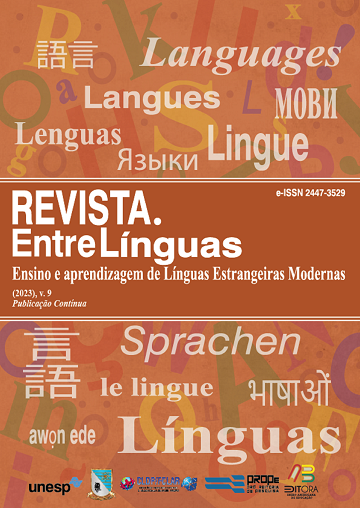Interacciones del lenguaje y las matemáticas
Cesaro – como suma de ciertas series divergentes
DOI:
https://doi.org/10.29051/el.v9i00.17895Palabras clave:
Linguagem, Matemática, Polinômios eulerianos, Relação de recorrência, Cesaro – como somaResumen
Las matemáticas tienen su lenguaje especial, que incluye la gramática y los símbolos compartidos por los matemáticos universalmente, independientemente de su lengua materna. Como las matemáticas son las mismas en todo el mundo, pueden servir como un lenguaje global. La idea de asignar ciertos valores finitos específicos a ciertas series divergentes se llama Cesaro Sum. Este artículo trata de analizar la interacción entre matemática y lenguaje, considerando a Cesaro – como suma de ciertas series divergentes. Para lograr este objetivo, se utilizan polinomios eulerianos. Además, se define un nuevo método para determinar los valores de la suma de Cesaro integrando funciones generadoras particulares sobre los intervalos cerrados y acotados para una serie general de potencias infinitas cuyos coeficientes son m-ésimas potencias de números naturales. Las respuestas obtenidas brindan nuevos conocimientos para comprender el proceso de suma de Cesaro y ofrecen una gran generalización y también revelan la misteriosa interacción de las matemáticas y el lenguaje.
Descargas
Citas
BLUMS, A. et al. Building links between early socioeconomic status, cognitive ability, and math and science achievement. Journal of Cognition and Development, v. 18, n. 1, p. 16-40, 2017.
GENLOTT, A. A.; GRÖNLUND, Å. Closing the gaps–Improving literacy and mathematics by ict-enhanced collaboration. Computers & Education, n. 99, p. 68-80, 2016.
HOFMANN, R.; MERCER, N. Teacher interventions in small group work in secondary mathematics and science lessons. Language and education, v. 30, n. 5, p. 400-416, 2016.
LEHRL, S. et al. Long-term and domain-specific relations between the early years home learning environment and students’ academic outcomes in secondary school. School Effectiveness and School Improvement, v. 31, n. 1, p. 102-124, 2020.
LEYVA, D. et al. Teacher–child interactions in Chile and their associations with prekindergarten outcomes. Child development, v. 86, n. 3, p. 781-799, 2015.
MARTIN, D. P.; RIMM-KAUFMAN, S. E. Do student self-efficacy and teacher-student interaction quality contribute to emotional and social engagement in fifth grade math?. Journal of school psychology, v. 53, n. 5, p. 359-373, 2015.
PENG, P. et al. Examining the mutual relations between language and mathematics: A meta-analysis. Psychological Bulletin, v. 146, n. 7, p. 595, 2020.
PURPURA, D. J.; REID, E. E. Mathematics and language: Individual and group differences in mathematical language skills in young children. Early Childhood Research Quarterly, v. 36, p. 259-268, 2016.
REDISH, E. F.; KUO, E. Language of physics, language of math: Disciplinary culture and dynamic epistemology. Science & Education, v. 24, n. 5, p. 561-590, 2015.
RIMM-KAUFMAN, S. E. et al. To what extent do teacher–student interaction quality and student gender contribute to fifth graders’ engagement in mathematics learning?. Journal of Educational Psychology, v. 107, n. 1, p. 170, 2015.
ULATOWSKI, F. et al. Recognizing the limited applicability of Job plots in studying host–guest interactions in supramolecular chemistry. The Journal of organic chemistry, v. 81, n. 5, p. 1746-1756, 2016.
Descargas
Publicado
Cómo citar
Número
Sección
Licencia

Esta obra está bajo una licencia internacional Creative Commons Atribución-NoComercial-CompartirIgual 4.0.
Os manuscritos aceitos e publicados são de propriedade da Revista EntreLínguas. Os artigos publicados e as referências citadas na Revista EntreLínguas são de inteira responsabilidade de seus autores.
Transferência de direitos autorais – autorização para publicação
Caso o artigo submetido seja aprovado para publicação, já fica acordado que o(s) autor(es) autoriza(m) a UNESP a reproduzi-lo e publicá-lo na EntreLínguas, entendendo-se os termos “reprodução” e “publicação” conforme definição respectivamente dos incisos VI e I do artigo 5° da Lei 9610/98. O artigo poderá ser acessado pela rede mundial de computadores (Internet), sendo permitidas, a título gratuito, a consulta e a reprodução de exemplar do artigo para uso próprio de quem a consulta, desde que haja a citação ao texto consultado. Essa autorização de publicação 328 EntreLínguas, Araraquara, v. 1, n .2, p. 323-328, jul./dez. 2015 não tem limitação de tempo, ficando a UNESP responsável pela manutenção da identificação do(s) autor(es) do artigo. Os artigos publicados e as referências citadas na Revista EntreLínguas são de inteira responsabilidade de seus autores.











